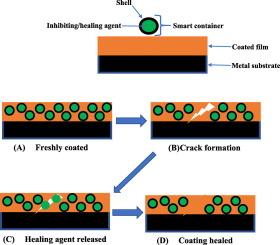A comprehensive review of stimulus-based smart self-healing coatings for substrate protection
IF 7.3
2区 材料科学
Q1 CHEMISTRY, APPLIED
引用次数: 0
Abstract
Smart self-healing coatings represent a transformative advancement in corrosion protection, offering dynamic responses to environmental stimuli like pH fluctuations, temperature changes, and mechanical damage. This review outlines the evolution of corrosion protection strategies, highlighting the limitations of traditional coatings and the emergence of intelligent systems that autonomously and non-autonomously detect and repair damage. It sets the record straight on the discrepancies between autonomous, non-autonomous, intrinsic, and extrinsic self-healing coatings and their combinations for wholesome self-healing architecture. Central to these innovations are mechanisms like autonomous-intrinsic, autonomous-extrinsic, non-autonomous intrinsic, and non-autonomous extrinsic self-healing coatings, facilitated by reversible bonds, microcapsules, shape memory alloys, nanocapsules, and vascular networks that store and release inhibitors and healing agents upon activation. The review also discusses the synthesis and application of these containers, emphasizing their importance in enhancing self-healing capabilities. Furthermore, the study highlights the next direction in integrating environmentally friendly phytochemical corrosion inhibitors, further underscoring the shift towards sustainable solutions. Economically, smart coatings promise reduced maintenance costs, extended service life, and decreased environmental impact, aligning with industry demands for durability and efficiency. Market analysts project significant growth, with the self-healing coatings market expected to reach approximately USD 10 billion by 2028, driven by applications across automotive, construction, and aerospace sectors. This review consolidates current knowledge on smart self-healing coatings, elucidating their mechanisms, benefits, challenges, and potential to redefine standards in corrosion protection, making it a valuable resource for researchers and professionals in materials science and engineering. It also discusses future directions for development and application in various industries.

基于刺激的智能自修复涂层用于基材保护的综合综述
智能自修复涂层代表了腐蚀防护领域的革命性进步,可以对环境刺激(如pH波动、温度变化和机械损伤)提供动态响应。本文概述了腐蚀防护策略的发展,强调了传统涂层的局限性,以及自主和非自主检测和修复损伤的智能系统的出现。它直接记录了自主、非自主、内在和外在自愈涂层之间的差异,以及它们对健康的自愈建筑的组合。这些创新的核心是自主-内在、自主-外在、非自主-内在和非自主-外在自愈涂层等机制,这些机制由可逆键、微胶囊、形状记忆合金、纳米胶囊和血管网络促进,这些血管网络在激活时储存和释放抑制剂和愈合剂。本文还讨论了这些容器的合成和应用,强调了它们在提高自愈能力方面的重要性。此外,该研究强调了整合环境友好型植物化学腐蚀抑制剂的下一个方向,进一步强调了向可持续解决方案的转变。在经济上,智能涂料承诺降低维护成本,延长使用寿命,减少对环境的影响,符合行业对耐用性和效率的要求。市场分析师预测,在汽车、建筑和航空航天领域的应用推动下,到2028年,自修复涂料市场预计将达到约100亿美元。本文综述了目前关于智能自修复涂层的知识,阐明了它们的机制、优点、挑战和重新定义腐蚀防护标准的潜力,使其成为材料科学和工程领域研究人员和专业人士的宝贵资源。并讨论了未来在各行业的发展和应用方向。
本文章由计算机程序翻译,如有差异,请以英文原文为准。
求助全文
约1分钟内获得全文
求助全文
来源期刊

Progress in Organic Coatings
工程技术-材料科学:膜
CiteScore
11.40
自引率
15.20%
发文量
577
审稿时长
48 days
期刊介绍:
The aim of this international journal is to analyse and publicise the progress and current state of knowledge in the field of organic coatings and related materials. The Editors and the Editorial Board members will solicit both review and research papers from academic and industrial scientists who are actively engaged in research and development or, in the case of review papers, have extensive experience in the subject to be reviewed. Unsolicited manuscripts will be accepted if they meet the journal''s requirements. The journal publishes papers dealing with such subjects as:
• Chemical, physical and technological properties of organic coatings and related materials
• Problems and methods of preparation, manufacture and application of these materials
• Performance, testing and analysis.
 求助内容:
求助内容: 应助结果提醒方式:
应助结果提醒方式:


